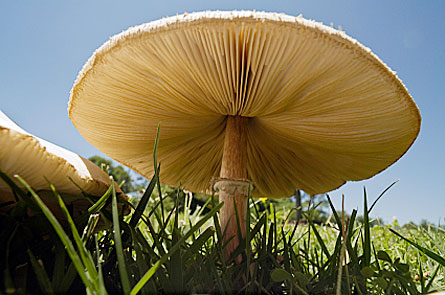A Mushrooming Advance
Across the globe, legions of people — young and old, dark-skinned and light — are experiencing a shortfall of vitamin D, also known as the “sunshine vitamin.” Today, the U.S. Department of Agriculture reported that its scientists had succeeded in upping the contribution mushrooms make in fulfilling our vitamin D needs.

It’s a step in the right direction. Unfortunately, it’s a teeny one. But the way USDA described its accomplishment, the public would never know that.
Depending on someone’s age, the recommended daily intake for this vitamin is 5 to 15 micrograms (usually expressed as 200 to 600 international units). USDA’s researchers in San Francisco and Albany, Calif., treated mushrooms to sun-tanning sessions of up to 18 minutes. Instead of developing a bronze glow, their fungal delights generated nearly 4 micrograms of vitamin D per gram of tissue. So it wouldn’t be impossible for mushrooms to meet our daily needs, an agency press release noted today.
The problem: Most people need considerably more than 5 to 15 micrograms. It’s something we at Science News have reported about extensively about throughout the past four years (and this message has slowly been filtering into the nonscience news media as well over the past year).
The current recommendation was set years ago and assumed that people’s skin got more exposure to the sun’s ultraviolet rays than they typically do today. Moreover, the value was set largely to prevent rickets in children, not to foster optimal health.
The American Academy of Dermatology has done a good job of scaring people away from the sun’s potentially cancer-causing rays. Indeed, its webpage carries a Nov. 1, 2008 message stating that: “an adequate amount of vitamin D should be obtained from a healthy diet that includes foods naturally rich in vitamin D, foods/beverages fortified with vitamin D, and/or vitamin D supplements; it should not be obtained from unprotected exposure to ultraviolet (UV) radiation.”
The skin of a lifeguard working outdoors in summer can make the equivalent of 250 micrograms of vitamin D a day — without ill effect from vitamin D. On the flip side, dozens of studies are published each year linking a deficiency in vitamin D to diseases that range from osteoporosis ands cancer to autoimmune disorders. The most recent condition linked with too little D: Parkinson’s disease.
So how much more than the official recommended daily intake do people need now that they’ve become sun shy? That depends on a host of factors, like:
— age: The elderly tend to need more, often because they spend so much time indoors
— skin color: Darkly pigmented skin filters out ultraviolet light, so that it takes higher sun exposures to make much vitamin D
— latitude: As distance from the equator increases, the amount of UV-filtering atmosphere between the sun and our skin also increases, and
— body fat: For reasons that are still not quite understood, heavier people seem to require more sunlight to develop adequate concentrations of vitamin D.
Studies have shown that people with one of more of these D-limiting factors might need 50 to 75 micrograms of supplemental D per day to develop healthful amounts of the vitamin’s active form in their blood. And don’t take my word on this: The experts who signed off on the recommended daily limit noted at the time that they knew the limit was too low. They were just waiting for in-press papers to be published (because recommended dietary intakes can only be based on published studies).
Don’t get me wrong, I applaud the USDA achievement. Its scientists have shown the D-enhancement in white, brown, and Portobello mushrooms. And it gives people another reason to eat these immunity-enhancing treats. But it’s a bit fraudulent to describe the achievement as providing people a dietary source of all the vitamin D they need.






